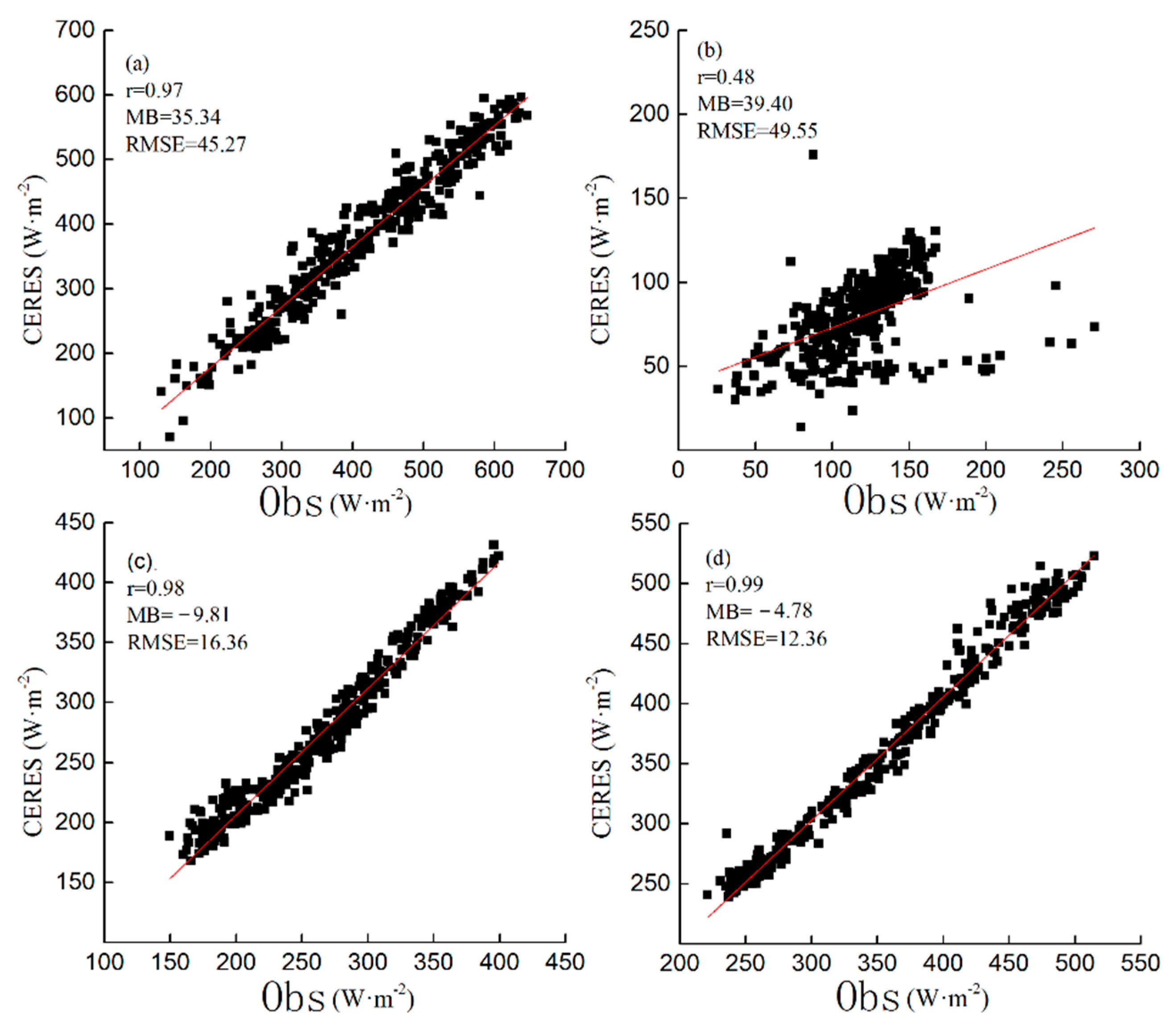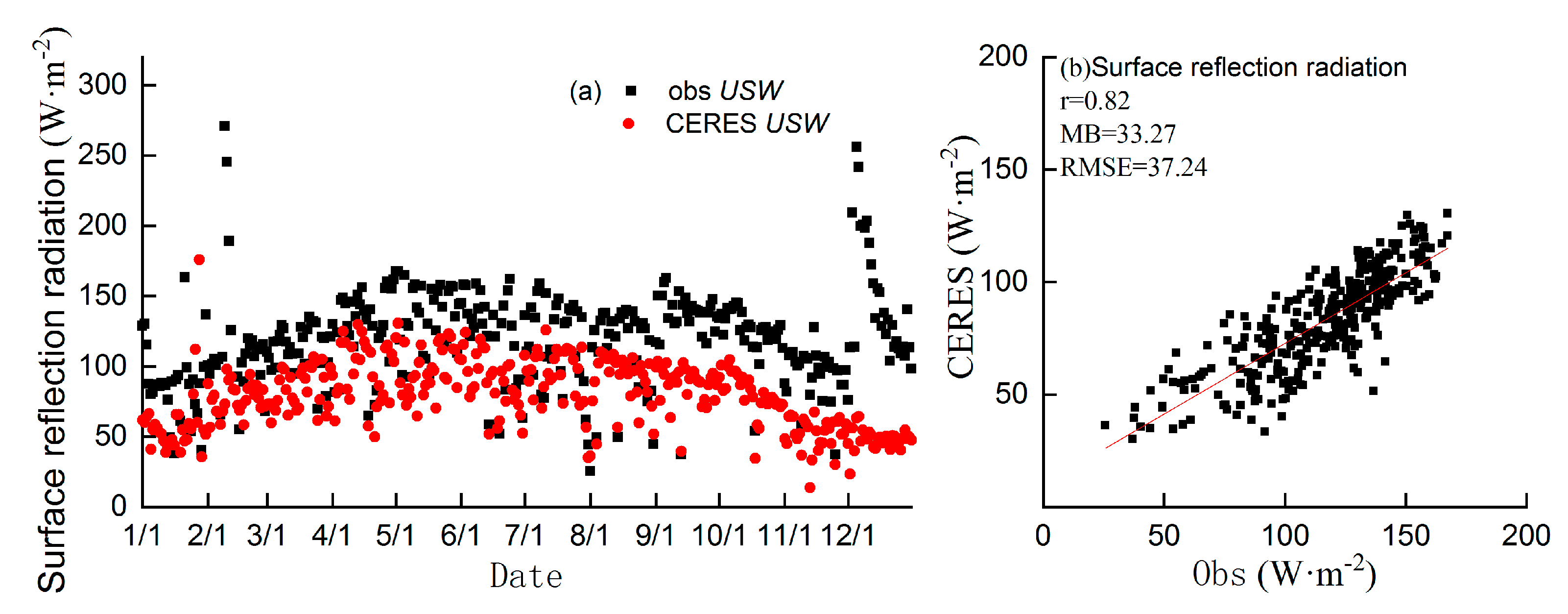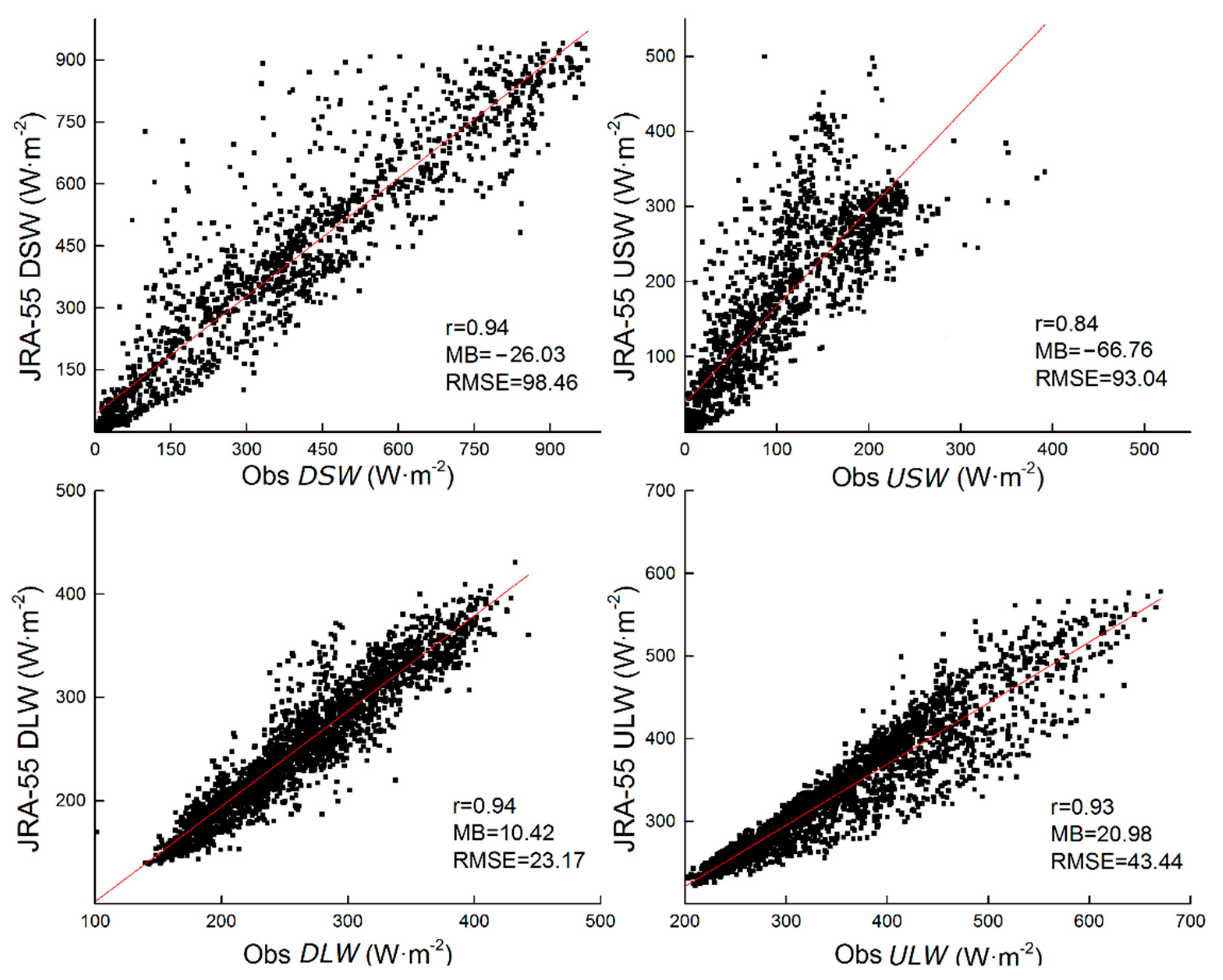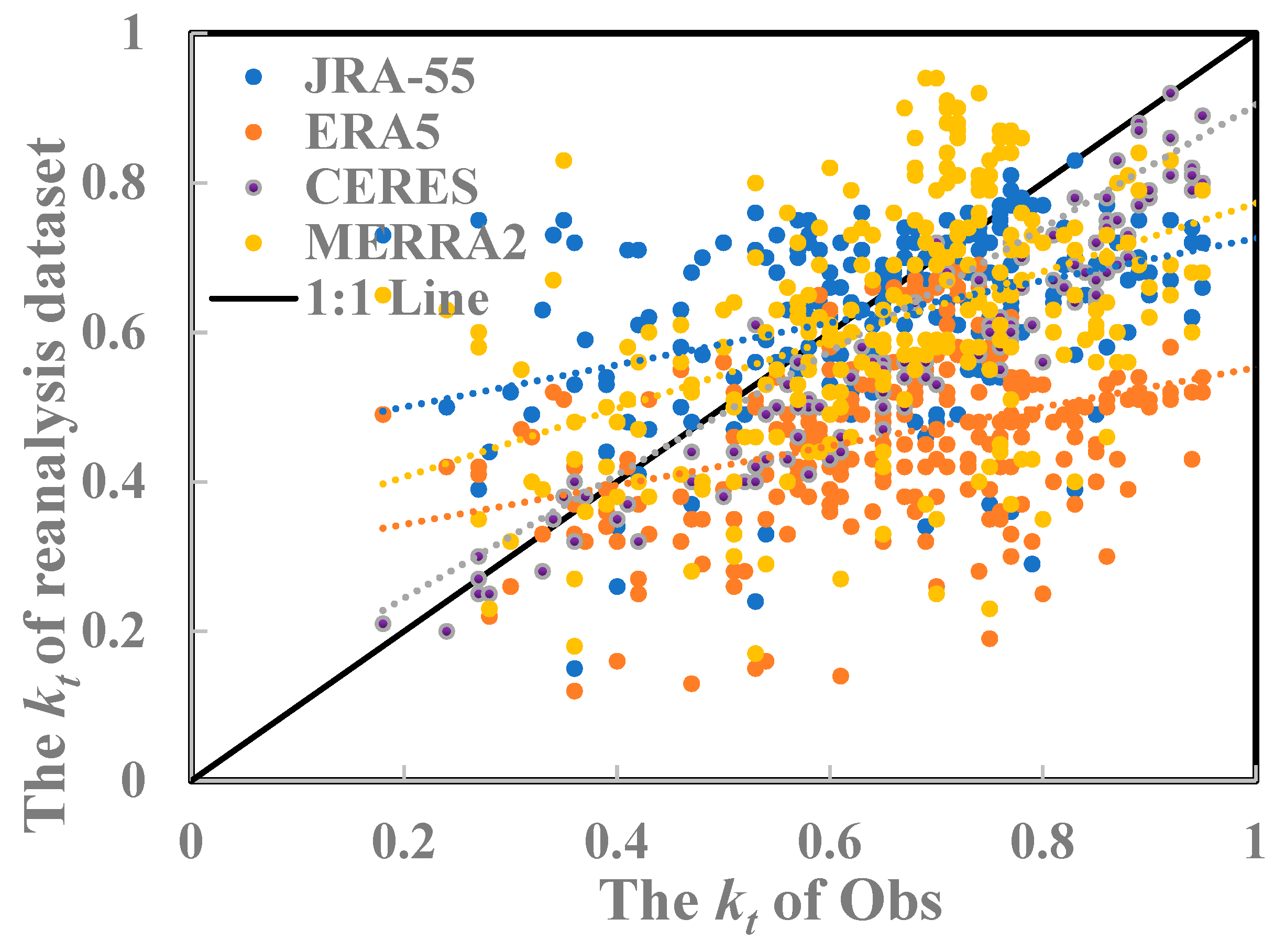Evaluation of Reanalysis Datasets for Solar Radiation with In Situ Observations at a Location over the Gobi Region of Xinjiang, China
Abstract
:1. Introduction
2. Data and Method
2.1. The Study Area
2.2. Surface Observation Data
2.3. Satellite Data
2.4. Reanalysis Dataset
2.5. Data Processing
3. Results
3.1. Conventional Analysis of Radiation
3.2. Applicability Evaluation of the CERES Satellite Data
3.3. Applicability Evaluation of Reanalysis Datasets
3.3.1. Applicability Evaluation of ERA5 and MERRA2 Reanalysis Datasets
3.3.2. Applicability Evaluation of the JRA-55 Reanalysis Dataset
3.3.3. Accuracy Evaluation of Reanalysis Datasets under Different Cloud Covers
3.3.4. Comparison of Clearness Index
3.3.5. Bias Correction by Linear Adaptation
4. Discussion
5. Conclusions
Author Contributions
Funding
Institutional Review Board Statement
Informed Consent Statement
Data Availability Statement
Conflicts of Interest
References
- Fang, H.; Qin, W.; Wang, L.; Zhang, M.; Yang, X. Solar brightening/dimming over China’s mainland: Effects of atmospheric aerosols, anthropogenic emissions, and meteorological conditions. Remote Sens. 2020, 13, 88. [Google Scholar] [CrossRef]
- He, Y.; Wang, K.; Feng, F. Improvement of ERA5 over ERA-Interim in simulating surface incident solar radiation throughout China. J. Clim. 2021, 34, 3853–3867. [Google Scholar] [CrossRef]
- Zha, L. Temporal and spatial variation of surface solar radiation in China. Geogr. Sci. 1996, 16, 232. (In Chinese) [Google Scholar]
- Zhou, Y.; Wu, W.; Hu, Y.; Liu, G. Spatial distribution characteristics and potential assessment of solar energy resources in Northwest China. J. Nat. Resour. 2010, 25, 1738–1749. (In Chinese) [Google Scholar]
- Wang, F.; Wang, Q.; Liu, S.; Chai, C.; Wang, F.; Liu, S.; Sun, T.; Zhu, S. Application of photovoltaic power generation in the desert and gobi and analysis of its ecological benefits. Open J. Nat. Sci. 2020, 8, 136–141. [Google Scholar] [CrossRef]
- Qi, Y.; Fang, S.B.; Zhou, W.Z. Variation and spatial distribution of surface solar radiation in China over recent 50 years. J. Ecol. 2014, 34, 7444–7453. [Google Scholar] [CrossRef] [Green Version]
- Zhang, X.; Lu, N.; Yao, L.; Jiang, H. Error analysis of ECMWF surface solar radiation data in China. Geo Inf. Sci. 2018, 20, 254–267. (In Chinese) [Google Scholar] [CrossRef]
- Jia, B.; Xie, Z.; Dai, A.; Shi, C.; Chen, F. Evaluation of satellite and reanalysis products of downward surface solar radiation over East Asia: Spatial and seasonal variations. J. Geophys. Res. Atmos. 2013, 118, 3431–3446. [Google Scholar] [CrossRef]
- Pang, M.; Zhou, D.; Chen, Y.; Zhong, K.; Xin, Y.; Qing, R.; Liu, Q.; Hu, J. Temporal and spatial distribution characteristics of downward shortwave radiation in Xinjiang. Based Ceres Aqua Satell. Data 2017, 11, 9–15. (In Chinese) [Google Scholar]
- Yan, H.; Huang, J.; Minnis, P.; Wang, T.; Bi, J. Comparison of CERES surface radiation fluxes with surface observations over Loess Plateau. Remote Sens. Environ. 2011, 115, 1489–1500. [Google Scholar] [CrossRef] [Green Version]
- Urraca, R.; Huld, T.; Gracia-Amillo, A.; Martínez-De-Pisón, F.; Kaspar, F.; Sanz-Garcia, A. Evaluation of global horizontal irradiance estimates from ERA5 and COSMO-REA6 reanalyses using ground and satellite-based data. Sol. Energy 2018, 164, 339–354. [Google Scholar] [CrossRef]
- Johnston, B.; Randel, W.; Sjoberg, J. Evaluation of tropospheric moisture characteristics among COSMIC-2, ERA5, and MERRA-2 in the tropics and subtropics. Remote Sens. 2021, 13, 880. [Google Scholar] [CrossRef]
- Zhao, T.B.; Fu, C.B. Preliminary comparison and analysis between ERA-40, NCEP-2 reanalysis and observations over China. Clim. Environ. Res. 2006, 11, 14–32. [Google Scholar] [CrossRef]
- Zhang, R.; Zhang, S.; Luo, J.; Han, Y.; Zhang, J. Analysis of near-surface wind speed change in China during 1958–2015. Theor. Appl. Clim. 2019, 137, 2785–2801. [Google Scholar] [CrossRef]
- Sianturi, Y.; Marjuki; Sartika, K. Evaluation of ERA5 and MERRA2 reanalyses to estimate solar irradiance using ground observations over Indonesia region. In Proceedings of the International Energy Conference ASTECHNOVA 2019, Yogyakarta, Indonesia, 6 April 2020. [Google Scholar] [CrossRef]
- Yiming, F.; Bo, W.; Aidong, Y. A study on classification system and inventory of gobi. Acta Geogr. J. 2014, 69, 391–398. [Google Scholar] [CrossRef]
- Xian, D.; Zheng, X.; Li, X.; Li, Y. Characteristics of climate change in the black gobi region of China. Acta Meteorol. Sin. 2014, 30, 81–87. (In Chinese) [Google Scholar]
- Zhang, Q.; Wei, G.; Huang, R.; Cao, X. Bulk transfer coefficients of the atmospheric momentum and sensible heat over desert and Gobi in arid climate region of Northwest China. Sci. China 2002, 45, 468–480. [Google Scholar] [CrossRef]
- Keqin, G.; Lianhai, H. Iguanians from the upper Cretaceous Djadochta formation, Gobi Desert, China. J. Vertebr. Paléontol. 1995, 15, 57–78. [Google Scholar] [CrossRef]
- Shen, Y.; Wang, X.; Cheng, W.; Wu, J.; Lu, Q.; Feng, Y. Study on the comprehensive natural regionalization of Gobi in China. Prog. Geogr. Sci. 2016, 35, 59–68. (In Chinese) [Google Scholar]
- Li, R. Climatic characteristics of temperature and precipitation in Hongliuhe. Agric. Technol. Serv. 2009, 26, 107–108. (In Chinese) [Google Scholar]
- Muñoz-Sabater, J.; Dutra, E.; Agustí-Panareda, A.; Albergel, C.; Arduini, G.; Balsamo, G.; Boussetta, S.; Choulga, M.; Harrigan, S.; Hersbach, H.; et al. ERA5-Land: A state-of-the-art global reanalysis dataset for land applications. Earth Syst. Sci. Data Discuss. 2021, 3, 1–5. [Google Scholar] [CrossRef]
- Reichle, R.H.; Koster, R.D.; De Lannoy, G.J.; Forman, B.A.; Liu, Q.; Mahanama, S.P.; Touré, A. Assessment and enhancement of MERRA land surface hydrology estimates. J. Clim. 2011, 24, 6322–6338. [Google Scholar] [CrossRef] [Green Version]
- Iqbal, M. An Introduction to Solar Radiation; Academic Press: Toronto, ON, Canada, 1983; Volume 39, pp. 387–390. ISBN 0123737508. [Google Scholar]
- Qing, H.; Li, J.L.; Hua, Y.X. Characteristics and influencing factors of ultraviolet radiation in desert hinterland. Desert Oasis Meteorol. 2011, 5, 7–14. (In Chinese) [Google Scholar]
- Gu, L.; Fuentes, J.D.; Shugart, H.H.; Staebler, R.M.; Black, T.A. Responses of net ecosystem exchanges of carbon dioxide to changes in cloudiness: Results from two North American deciduous forests. J. Geophys. Res. Atmos. 1999, 104, 31421–31434. [Google Scholar] [CrossRef]
- Smith, C.J.; Bright, J.M.; Crook, R. Cloud cover effect of clear-sky index distributions and differences between human and automatic cloud observations. Sol. Energy 2017, 144, 10–21. [Google Scholar] [CrossRef] [Green Version]
- Zhang, X.; Liang, S.; Wang, G.; Yao, Y.; Jiang, B.; Cheng, J. Evaluation of the reanalysis surface incident shortwave radiation products from NCEP, ECMWF, GSFC, and JMA using satellite and surface observations. Remote Sens. 2016, 8, 225. [Google Scholar] [CrossRef] [Green Version]
- Glahn, H.R.; Lowry, D.A. The use of model output statistics (MOS) in objective weather forecasting. J. Appl. Meteorol. 1972, 11, 1203–1211. [Google Scholar] [CrossRef] [Green Version]
- Polo, J.; Wilbert, S.; Ruiz-Arias, J.; Meyer, R.; Gueymard, C.; Suri, M.; Martin, L.; Mieslinger, T.; Blanc, P.; Grant, I.; et al. Integration of Ground Measurements with Model-Derived Data. 2015. Available online: https://elib.dlr.de/99181/ (accessed on 12 September 2021).
- Maraun, D. Bias correcting climate change simulations—A critical review. Curr. Clim. Chang. Rep. 2016, 2, 211–220. [Google Scholar] [CrossRef] [Green Version]
- Maraun, D.; Wetterhall, F.; Ireson, A.; Chandler, R.; Kendon, E.J.; Widmann, M.; Brienen, S.; Rust, H.; Sauter, T.; Themeßl, M.; et al. Precipitation downscaling under climate change: Recent developments to bridge the gap between dynamical models and the end user. Rev. Geophys. 2010, 48, 48. [Google Scholar] [CrossRef]
- Teutschbein, C.; Seibert, J. Bias correction of regional climate model simulations for hydrological climate-change impact studies: Review and evaluation of different methods. J. Hydrol. 2012, 456–457, 12–29. [Google Scholar] [CrossRef]
- Hempel, S.; Frieler, K.; Warszawski, L.; Schewe, J.; Piontek, F. A trend-preserving bias correction-the ISI-MIP approach. Earth Syst. Dyn. 2013, 4, 219–236. [Google Scholar] [CrossRef] [Green Version]
- Harding, R.J.; Weedon, G.P.; Van Lanen, H.A.; Clark, D.B. The future for global water assessment. J. Hydrol. 2014, 518, 186–193. [Google Scholar] [CrossRef] [Green Version]
- Wang, C.; Wei, Z.; Li, Z.; Xiao, T.; Ni, C. Simulation of land surface processes on Gobi underlying surface in Arid Northwest China. Acta Sol. Sin. 2016, 37, 2422–2429. (In Chinese) [Google Scholar]
- Brunt, D. Notes on radiation in the atmosphere. Q. J. R. Meteorol. Soc. 1932, 58, 389–420. [Google Scholar] [CrossRef]
- Berdahl, P. Emissivity of clear skies. Sol. Energy 1984, 32, 663–664. [Google Scholar] [CrossRef]
- Shen, Y.; Zhao, Z.; Shi, G. The latest research progress on the variation of surface solar radiation, its influencing factors and possible climate effects. Prog. Earth Sci. 2008, 9, 915–923. (In Chinese) [Google Scholar] [CrossRef]
- Zib, B.J.; Dong, X.; Xi, B.; Kennedy, A. Evaluation and intercomparison of cloud fraction and radiative fluxes in recent reanalyses over the Arctic using BSRN surface observations. J. Clim. 2012, 25, 2291–2305. [Google Scholar] [CrossRef]
- Niu, S.J.; Wang, C.Z.; Yue, P. Case study of dust event on surface heat and radiation budget over gobi in Heihe basin during winter to spring. J. Desert Res. 2010, 30, 407–412. (In Chinese) [Google Scholar]
- Romano, S.; Perrone, M.R. Mineral dust impact on short- and long-wave radiation and comparison with ceres measurements. EPJ Web Conf. 2016, 119, 8005. [Google Scholar] [CrossRef] [Green Version]
- Radkevich, A.; Khlopenkov, K.; Rutan, D.; Kato, S. A supplementary clear-sky snow and ice recognition technique for CERES level 2 products. J. Atmos. Ocean. Technol. 2013, 30, 557–568. [Google Scholar] [CrossRef] [Green Version]
- Minnis, P.; Sun-Mack, S.; Chen, Y.; Chang, F.-L.; Yost, C.R.; Smith, W.L.; Heck, P.W.; Arduini, R.F.; Bedka, S.T.; Yi, Y.; et al. CERES MODIS Cloud product retrievals for edition 4-Part I: Algorithm changes. IEEE Trans. Geosci. Remote Sens. 2021, 59, 2744–2780. [Google Scholar] [CrossRef]
- Chen, G.; Iwasaki, T.; Qin, H.; Sha, W. Evaluation of the warm-season diurnal variability over east Asia in recent reanalysis JRA-55, ERA-Interim, NCEP CFSR, and NASA MERRA. J. Clim. 2014, 27, 5517–5537. [Google Scholar] [CrossRef]
- Yi, Y.; Kimball, J.S.; Jones, L.A.; Reichle, R.; McDonald, K.C. Evaluation of MERRA land surface estimates in preparation for the soil moisture active passive mission. J. Clim. 2011, 24, 3797–3816. [Google Scholar] [CrossRef] [Green Version]
- Wang, A.; Zeng, X. Evaluation of multireanalysis products with in situ observations over the Tibetan Plateau. J. Geophys. Res. Atmos. 2012, 117, 1–12. [Google Scholar] [CrossRef]
- You, Q.; Fraedrich, K.; Ren, G.; Pepin, N.; Kang, S. Variability of temperature in the Tibetan Plateau based on homogenized surface stations and reanalysis data. Int. J. Climatol. 2013, 33, 1337–1347. [Google Scholar] [CrossRef] [Green Version]
- Peng, X. Global Solar Radiation Reanalysis Product Error and Influence Factor Analysis. Doctoral Dissertation, Nanjing University, Nanjing, China, 2019. (In Chinese). [Google Scholar]
- Boilley, A.; Wald, L. Comparison between meteorological re-analyses from ERA-Interim and MERRA and measurements of daily solar irradiation at surface. Renew. Energy 2015, 75, 135–143. [Google Scholar] [CrossRef]
- Tahir, Z.U.R.; Azhar, M.; Blanc, P.; Asim, M.; Imran, S.; Hayat, N.; Shahid, H.; Ali, H. The evaluation of reanalysis and analysis products of solar radiation for Sindh province, Pakistan. Renew. Energy 2020, 145, 347–362. [Google Scholar] [CrossRef]
- Dolinar, E.K.; Dong, X.; Xi, B.; Jiang, J.H.; Loeb, N.G. A clear-sky radiation closure study using a one-dimensional radiative transfer model and collocated satellite-surface-reanalysis data sets. J. Geophys. Res. Atmos. 2016, 121, 13–698. [Google Scholar] [CrossRef] [Green Version]
- Tahir, Z.U.R.; Azhar, M.; Mumtaz, M.; Asim, M.; Moeenuddin, G.; Sharif, H.; Hassan, S. Evaluation of the reanalysis surface solar radiation from NCEP, ECMWF, NASA, and JMA using surface observations for Balochistan, Pakistan. J. Renew. Sustain. Energy 2020, 12, 023703. [Google Scholar] [CrossRef]
- Babar, B.; Graversen, R.; Boström, T. Solar radiation estimation at high latitudes: Assessment of the CMSAF databases, ASR and ERA5. Sol. Energy 2019, 182, 397–411. [Google Scholar] [CrossRef]








| DSW | USW | NSW | DLW | ULW | NLW | |
|---|---|---|---|---|---|---|
| r | 0.97 | 0.48 | 0.85 | 0.98 | 0.99 | 0.99 |
| MB (W·m−2) | 35.34 | 39.40 | 31.6 | −9.81 | −4.78 | −7.29 |
| rMB (%) | 8.51 | 33.12 | 8.51 | −3.71 | −1.32 | −2.51 |
| RMSE (W·m−2) | 45.27 | 49.55 | 42.3 | 16.36 | 12.36 | −12.35 |
| NSW | NLW | |||
|---|---|---|---|---|
| ERA5 | MERRA2 | ERA5 | MERRA2 | |
| r | 0.91 | 0.88 | 0.92 | 0.88 |
| MB (W·m−2) | 11.79 | 7.46 | 9.22 | 6.39 |
| rMB (%) | 3.98% | 2.52% | −9.37% | −6.50% |
| RMSE (W·m−2) | 46.31 | 50.08 | 16.33 | 17.36 |
| DSW | USW | NSW | DLW | ULW | NLW | |
|---|---|---|---|---|---|---|
| r | 0.94 | 0.84 | 0.91 | 0.94 | 0.93 | 0.94 |
| MB (W·m−2) | −26.03 | −66.76 | 16.51 | 10.42 | 20.98 | 15.71 |
| rMB (%) | −7.43 | −68.07 | 3.74 | 3.95 | 5.79 | 4.87 |
| RMSE (W·m−2) | 98.47 | 93.04 | 16.51 | 23.17 | 43.44 | 33.30 |
| a | NSW (%) | NLW (%) | ||
|---|---|---|---|---|
| ERA5 | MERRA2 | ERA5 | MERRA2 | |
| Sunny | 5.93 | 1.21 | −4.22 | −4.62 |
| Partly cloudy | 6.06 | 3.67 | −5.42 | −3.80 |
| Cloudy | 2.69 | 1.71 | −13.16 | −9.00 |
| Overcast | 0.76 | 2.04 | −16.88 | −9.69 |
| b | DSW (%) | USW (%) | DLW (%) | ULW (%) |
| Sunny | −2.94 | −61.89 | 3.11 | 6.11 |
| Partly cloudy | −3.6 | −71.96 | 3.24 | 5.03 |
| Cloudy | −9.99 | −63.4 | 3.52 | 4.51 |
| Dataset | Spring | Summer | Autumn | Winter | ||||
|---|---|---|---|---|---|---|---|---|
| rMB (%) | r | rMB (%) | r | rMB (%) | r | rMB (%) | r | |
| CERES | 10.4 | 0.96 | 20.1 | 0.94 | −34.2 | 0.21 | −68.2 | 0.19 |
| JRA-55 | 0.6 | 0.75 | 4.2 | 0.85 | −11.3 | 0.38 | −27.4 | 0.28 |
| ERA5 | 33.7 | 0.91 | 42.2 | 0.48 | 9.8 | 0.52 | −16.1 | 0.78 |
| MERRA2 | 11.2 | 0.94 | 23.1 | 0.21 | −22.0 | 0.41 | −70.4 | 0.16 |
| Dataset | NSW | NLW | ||||||
|---|---|---|---|---|---|---|---|---|
| r | RMSE (W·m−2) | MB (W·m−2) | rMB (%) | r | RMSE (W·m−2) | MB (W·m−2) | rMB (%) | |
| CERES | 0.85 | 42.3 | 31.6 | 8.51 | 0.99 | −12.35 | −7.29 | −2.51 |
| JRA−55 | 0.91 | 48.64 | 16.51 | 3.74 | 0.94 | 33.30 | 15.71 | 4.87 |
| ERA5 | 0.94 | 26.41 | 8.97 | 2.56 | 0.95 | 12.01 | 7.82 | −5.73 |
| MERRA2 | 0.90 | 27.34 | 5.62 | 2.53 | 0.91 | 13.24 | 3.85 | −3.35 |
Publisher’s Note: MDPI stays neutral with regard to jurisdictional claims in published maps and institutional affiliations. |
© 2021 by the authors. Licensee MDPI, Basel, Switzerland. This article is an open access article distributed under the terms and conditions of the Creative Commons Attribution (CC BY) license (https://creativecommons.org/licenses/by/4.0/).
Share and Cite
Wang, Y.; Zhao, X.; Mamtimin, A.; Sayit, H.; Abulizi, S.; Maturdi, A.; Yang, F.; Huo, W.; Zhou, C.; Yang, X.; et al. Evaluation of Reanalysis Datasets for Solar Radiation with In Situ Observations at a Location over the Gobi Region of Xinjiang, China. Remote Sens. 2021, 13, 4191. https://doi.org/10.3390/rs13214191
Wang Y, Zhao X, Mamtimin A, Sayit H, Abulizi S, Maturdi A, Yang F, Huo W, Zhou C, Yang X, et al. Evaluation of Reanalysis Datasets for Solar Radiation with In Situ Observations at a Location over the Gobi Region of Xinjiang, China. Remote Sensing. 2021; 13(21):4191. https://doi.org/10.3390/rs13214191
Chicago/Turabian StyleWang, Yu, Xueshang Zhao, Ali Mamtimin, Hajigul Sayit, Simayi Abulizi, Amina Maturdi, Fan Yang, Wen Huo, Chenglong Zhou, Xinghua Yang, and et al. 2021. "Evaluation of Reanalysis Datasets for Solar Radiation with In Situ Observations at a Location over the Gobi Region of Xinjiang, China" Remote Sensing 13, no. 21: 4191. https://doi.org/10.3390/rs13214191







